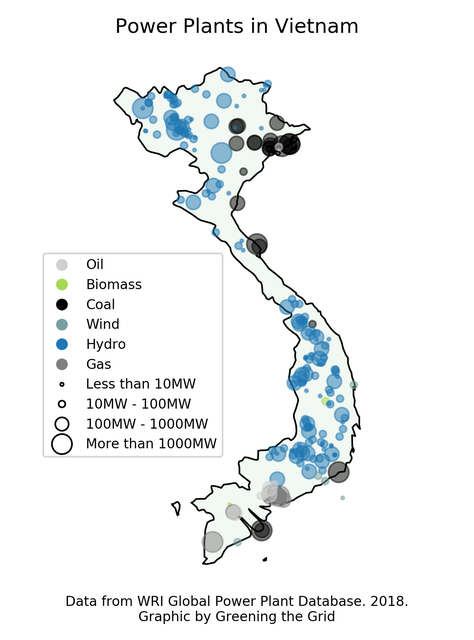Vietnam
Technical Support to Enhance DER Deployment in Vietnam
The Government of Vietnam is implementing distributed generation (DG), particularly distributed photovoltaic (DPV) programs in response to declining technology costs and burgeoning customer demand. NREL and the USAID Vietnam Urban Energy Security (VUES) project are supporting Vietnam’s utility, EVN, to better understand the financial and technical impacts of DPV through analysis and capacity building. NREL is utilizing an analysis framework and stakeholder engagements to evaluate the financial impact of various DPV deployment scenarios and compensation mechanisms for EVN in Danang City. The capacity building will provide EVN with a better understanding of technical impacts of DPV on the distribution system at different levels of DPV penetration and strategies for mitigating adverse impacts, largely drawing from international experiences.
Technical Support to Accelerate Integration of EV and EVSE into the Vietnam Grid
NREL is also supporting the USAID VUES Project by providing technical assistance to Vietnam Electricity (EVN), Vinbus, and the city of Danang to better understand the relevant issues and challenges of integrating EVs and EVSE into the grid in Vietnam, based on case studies, global experiences, and best practices. Through several workshops with EVN and Vinbus, NREL is providing technical assistance on the grid impacts of EVs, operation and maintenance guidelines for electric buses, standards and protocols for EVSE, tariff design, and workforce development.
Vietnam Low Emission Energy Program (V-LEEP)
Background
Electricity demand in Vietnam is expected to undergo significant changes and substantial growth over the coming years as customers adopt new “behind-the-meter” technologies and respond to economic drivers and market prices in real time. The generation, transmission and distribution systems will have to grow and evolve to meet this changing nature of electricity demand in a reliable, safe, transparent, environmentally responsible and economic manner.
The V-LEEP team, funded by the United States Agency for International Development (USAID), is helping the Government of Vietnam (GVN) establish an effective policy, regulatory, and incentive environment for low-emission growth in the energy sector, while simultaneously attracting public-sector and private-sector investment in renewable energy (RE) development and energy efficiency (EE). Three components form V-LEEP’s core tasks:
Component 1: Low Emission Strategy Development for the Energy Sector
- Task 1.1: Enhance GVN capacity to analyze and develop clean energy strategies and evaluate emission mitigation options for decision-making.
Component 2: Enhance Capacity and Improve Enabling Environment for Renewable Energy Development
- Task 2.1: Enhance capacity of Vietnamese government institutions to improve the enabling environment for RE development.
- Task 2.2: Enhance capacity of RE developers and the private sector in large-scale RE development.
Component 3: Increase Energy Efficiency Adoption and Compliance
- Task 3.1: Enhance government capacity to strengthen energy efficiency policy implementation.
To this end, under the scope of Component 1, the V-LEEP team is supporting the Electricity and Renewable Energy Authority (EREA), under the Ministry of Industry and Trade (MOIT), to develop a new guiding framework and a methodology to update Vietnam’s power development planning (PDP) process and incorporate international best practices in power planning for higher levels of variable renewable energy.
Study
The V-LEEP team has worked closely with NREL and HNEI to conduct an assessment of the planning process, identify the advantages and disadvantages of previous planning approaches, and recommend changes to the technical and institutional setup of agencies involved in the preparation of Vietnam’s upcoming Power Development Plan (PDP).
Findings and Recommendations
- An analysis of power system operations can be included in the PDP planning methodology to test the feasibility of the capacity expansion plans determined by long-term optimization models. The current PDP process does not sufficiently consider the short-to-medium-term operation of the power system.
- Regional analysis can include studies on 1) how physical and economic congestion affect the wholesale electricity market and 2) the availability of new generation resources such as distributed generation.
- Planning processes can consider the unique characteristics (such as variability, uncertainty and locational specificity) of variable renewable energy (VRE), e.g. wind and solar. Key changes proposed include:
- The need for input data that characterize the hourly or sub-hourly solar and wind generation at high spatial resolution;
- Consideration of solar and wind resource potential and geographic concentration in transmission planning; and
- The need for operational modeling (i.e., production cost simulations) that covers every period (e.g., hour, 30-minute increment) of the year, rather than only typical days or weeks.
Figure 1 compares the methodology used in Vietnam’s PDP-7 with international leading PDP practices, and Figure 2 shows the recommended PDP approach for PDP-8.
Figure 1: Comparing the PDP methodology used in Vietnam and the international leading PDP practices
Figure 2: Recommended PDP Approach
Power plant map


